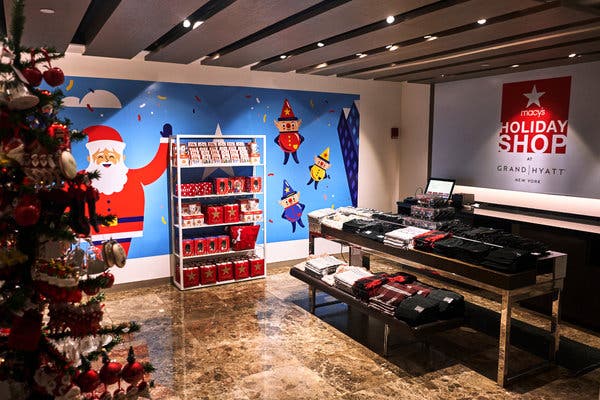If you’re looking for merchandise from some of New York City’s top department stores this holiday season, you may find it in surprising places: the lobbies of major Manhattan hotels.
Bloomingdale’s will be selling Baccarat crystal, French chocolates and more at the Loews Regency New York. For the second year, Nordstrom will have a pop-up presence at the JW Marriott Essex House New York on Central Park South, where it will offer men’s and women’s clothes. And for the third time, Macy’s is selling souvenirs, holiday ornaments and other merchandise in the lobby of the Grand Hyatt New York, near Grand Central Terminal.
And then there are the more elaborate partnerships.
F.A.O. Schwarz is collaborating with the nearby Conrad New York Midtown to create a high-end suite whose rate starts at $3,000 per night. Guests can play with and buy merchandise such as a dance-on piano and giant stuffed animals.
The Benjamin, which since 2013 has offered guests amenities to improve their sleep, will have a new pop-up in its lobby that sells slumber-friendly products like sleep-detox kits by Kaia Naturals and pajamas by Dagsmejan. And, working with the Well Traveled Trunk, a New York vintage luggage specialist, the Sofitel New York has created a 15-foot-tall Christmas tree for its lobby; it consists of 15 pieces of Louis Vuitton luggage dating from the 1880s to the 1930s that sell from $10,000 to $16,000 each.
“It’s about convenience, bringing the store to the customer,” said Henry Harteveldt, a travel analyst for Atmosphere Research. “And after seeing the pop-up, the guest can go to the retailer’s website in his or her hotel room, or to the store itself.”
Mr. Harteveldt noted that hotels and retailers worldwide frequently worked together, with the latter offering the former’s guests benefits like a personal shopper, gift cards, and free meals or alterations. But the lobby presence is designed to make even more of an impression on travelers, potentially valuable customers.
“If you catch someone on vacation, there’s a good chance you can catch her as a customer,” said Mortimer Singer, the chief executive of Traub, a retail consultancy. “They can afford to travel, they’re at ease, and they have a wish to spend.”
The total number of visitors to New York City this year is expected to reach 66.9 million, according to NYC & Company, the city’s tourism marketing agency. That would be an increase of 2.9 percent from last year and include an estimated seven million travelers between Thanksgiving and the end of the year. Last year, visitors spent $8.9 billion on retail, almost one-fifth of all their expenditures.
All of the hotels offering holiday retail experiences are members of NYC & Company, as are Macy’s, Nordstrom and Bloomingdale’s. The organization maintains a visitor center in Macy’s Herald Square flagship store.
New York appears to be the primary city for these kind of retail-hotel mash-ups, though examples can also be found in places like Washington. The fashion jewelry company Alexis Bittar rents a display case at the St. Regis in Washington and plans to offer a pop-up shopping experience there on Sunday to kick off the hotel’s holiday Champagne brunch. At the Conrad in Washington, guests in the most expensive suites are being offered personalized, in-room shopping with Moncler, the Italian puffer coat specialist; the local store delivers items to try on.
Andrew Lipsman, principal retail and e-commerce analyst for eMarketer, is forecasting that retail sales in the United States will rise 3.8 percent this holiday season, while the National Retail Federation is forecasting a climb of 3.8 to 4.2 percent.

Mr. Lipsman said he was not surprised that the retail-hotel holiday collaboration concept was primarily centered on New York so far.
“New York is the epicenter of retail,” he said. “New York is the epicenter of holiday travel.”
He added that stores like Macy’s, Nordstrom and Bloomingdale’s had a “fair amount of exposure in malls, where there is declining foot traffic.”
“They’re trying to remain relevant,” Mr. Lipsman said. “They are leaning into the experiential and doing it by experimenting. More than anything, they’re trying to recapture and maintain some brand cachet, create a halo effect for the brand.”
Bloomingdale’s aim in collaborating with the Loews Regency New York is “ultimately to drive traffic, visit the flagship,” said Frank Berman, executive vice president and chief marketing officer of Bloomingdale’s. “Our goal is to extend the reach for the brand in an aspirational setting.”
The holiday collaborations do not call for a major investment from retailers, said Jen Redding, consumer retail analyst for Wedbush Securities. The New York hotels said they were not charging rent for the pop-ups or getting a percentage of sales.
The luggage tree at the Sofitel New York — which also displayed vintage trunks from the Well Traveled Trunk last spring and frequently exhibits art in its lobby — is part of Sofitel’s worldwide effort to promote “Christmas couture,” said the hotel’s general manager, Simon Antoine.
“For us, it’s about creating something unique and different,” he said. “These days, if it’s not Instagrammable, does it even exist?”







